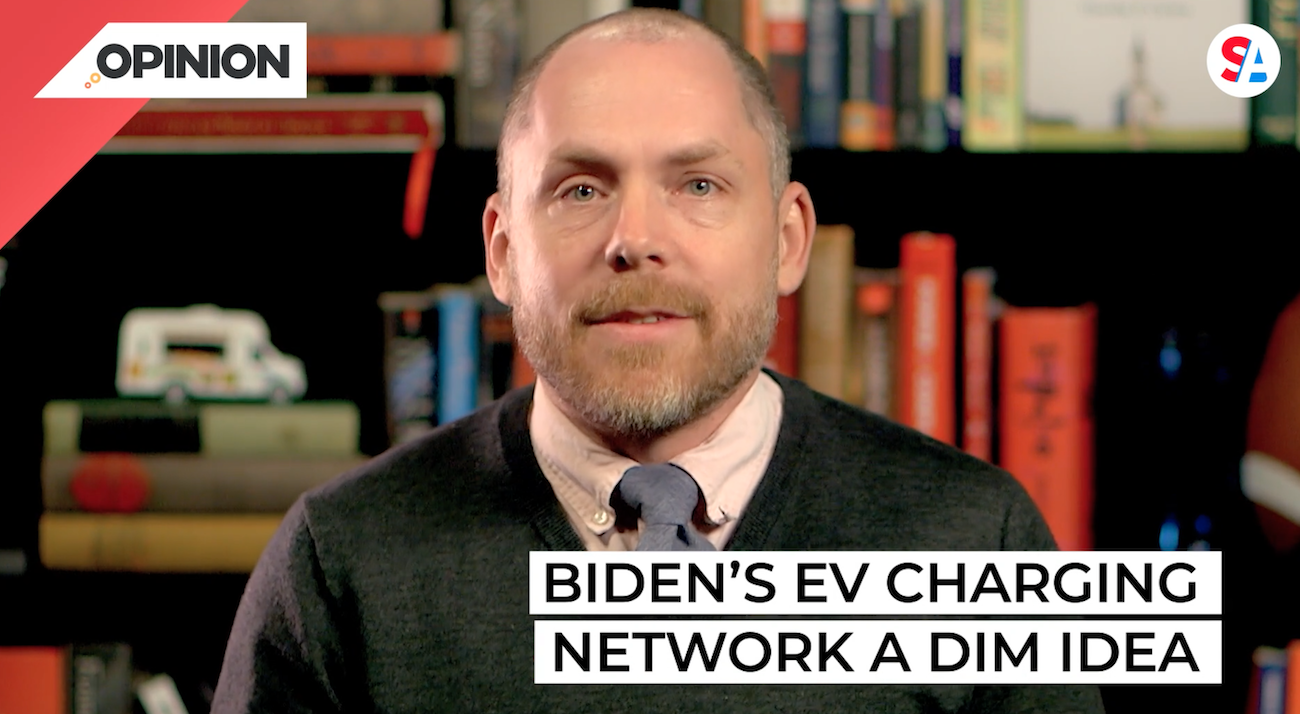
Commentary
-
Our commentary partners will help you reach your own conclusions on complex topics.
Coming soon to every part of America: A high voltage federal boondoggle—which is, frankly, a dim idea.
The plan is to spend billions to build chargers for electric cars.
A network of electric-car charging stations is a great idea. We have questions, though: Why does this plan involve building slow chargers instead of fast chargers, as Tesla has built?
The answer: Because the Biden administration is running the program, and they have decided that quantity outweighs quality.
The Bipartisan Infrastructure Bill that became law in November included $7.5 billion for building out a network of charging stations across the country.
But the charging stations they are planning to install are not rapid chargers, but slow ones—Level Two chargers, as they are called. These charge your car faster than you could by plugging in your car to a regular outlet in your house, but they still take an hour to give you enough charge to drive 25 miles.
Level Two chargers might help you refresh your battery while you’re doing your grocery shopping, but no network of them, however expansive, will enable you to take a road trip, because for every hour of driving, you’d have to do an hour of charging.
So why are Joe Biden and Kamala Harris building these slow chargers instead of rapid ones? Because during the campaign, candidate Biden promised half a million chargers.
To keep that promise, he has to go cheap.
The goal is to overcome a big consumer worry about electric cars: That you might run out of battery far more than a regular car will run out of gas. Slow chargers won’t overcome that fear, which means these billions may not do anything to increase electric car uptake.
It wouldn’t be the first time a dim idea became law and wasted billions of taxpayer dollars.
But there’s a bigger question here: Why is it a federal responsibility to install a bunch of chargers?
Sure, this is “infrastructure,” in a sense. But these aren’t highways, or railroads, or electric wires. Charging stations aren’t natural monopolies. They don’t require extensive rights-of-way.
A vehicle charger takes up less room than a hot dog cart and can be put in a parking lot.
There is no reason the private sector couldn’t foot the entire bill for these charging stations.
*Who* exactly would pay to build them? Well, let’s answer that question by looking at who lobbied Congress to subsidize the chargers. Those are the companies that stand to profit from this building spree.
First off, the stores that want the chargers in their parking lots have been lobbying on this. The National Association of Convenience Stores listed car chargers on their federal lobbying filings.
Berkshire Hathaway Energy—the power company owned by multibillionaire Warren Buffett—has lobbied on this issue, along with all the other power companies such as Edison Electric Institute and Exelon. Why? Because more charging means more electricity used, which means more money for Buffett, Edison, and Exelon.
Ford and General Motors are also lobbying for federally subsidized charging stations. They hope more stations will mean more electric vehicle sales.
A huge push to subsidize charging stations comes from a dedicated lobbying coalition called the Zero-Emissions Transportation Association. Their members include the companies that make the chargers, the carmakers, and other companies that would profit from this subsidy.
So if hundreds of companies are set to profit from this network of charging stations, and if they have already formed coalitions, why can’t these companies all build the charging stations themselves? That’s the way capitalism works: Investment comes from the companies that stand to profit.
Sadly, that’s not how Washington works. Special interests, instead of investing in innovation or infrastructure, invest in lobbyists, and they get politicians to force you, the taxpayer, to foot the bill.
So in the coming months, when you see these charging stations pop up, know that you paid for them. And if you have to plug your car into one of them, as they slowly recharge your battery, thank Uncle Sam for helping you develop the virtue of patience.
-
Universal school choice best for student, parents and communities
One of President Trump’s campaign promises was to “bring schools back to the states” and expand what he views as quality education through school choice, including vouchers and scholarships. As part of this effort, Secretary of Education Linda McMahon recently cut her department’s workforce by 50%, arguing that U.S. education will improve once its “bureaucracy”… -
Anti-deportation protests across US will hurt immigrants
On Feb. 2, thousands of protesters waving Mexican, Guatemalan and Salvadoran flags marched through downtown Los Angeles, shutting down the freeway in protest of Trump’s deportation plans. In Phoenix, Arizona, protesters rallied at the state capitol and outside federal immigration offices. Similar grassroots demonstrations are unfolding across the country in the early weeks of Trump’s… -
How woke Democratic policies are fueling devastating wildfires
With at least 25 people killed and fires still burning in Los Angeles, some are accusing politicians of mismanaging resources and worsening the crisis. President-elect Donald Trump has blamed California Gov. Gavin Newsom, a Democrat, claiming he is responsible for a low water supply, although city officials rebuked that allegation and have clarified that the… -
Democrats, GOP must urgently cooperate to block Trump tariffs
Incoming U.S. President Donald Trump has pledged sweeping tariffs on U.S. imports from around the globe, including from U.S. neighbors and allies, but especially on Chinese goods. Trump contends that his tariffs, while initially shocking the U.S. and global economies, will ultimately be good for the long-term economic health of the United States. But economists… -
Why Democrats have soured on mail-in voting
Over 4 million Georgians voted early in the U.S. 2024 presidential election, including a significantly higher number of Republicans than in 2016 or 2020, and many of them chose to do so by mail. The Georgia secretary of state’s office said that this early voting was unprecedented, representing 56% of all registered Georgia voters and…
Latest Opinions
-
Test post with no body copy
-
 Getty Images
Getty Images
How does dyeing the Chicago River on St. Patrick’s Day impact fish?
-
 Getty Images
Getty Images
Trapped Antarctic researchers reporting death threats from colleague
-
 Getty Images
Getty Images
Democratic Party’s favorability ratings drop to record low: Poll
-
 Getty Images
Getty Images
Israel accused of ‘genocidal acts’ against Palestinians in new UN report
Popular Opinions
-
In addition to the facts, we believe it’s vital to hear perspectives from all sides of the political spectrum.






